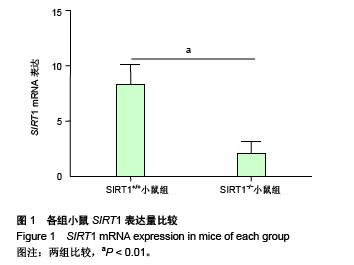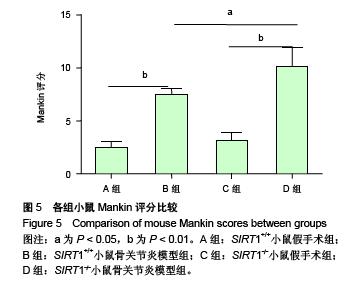| [1] Zhang W,Nuki G,Moskowitz RW,et al.OARSI recommendations for the management of hip and knee osteoarthritis:part Ⅲ: changes in evidence following systematic cumulativeupdate of research published through January 2009.Osteoarthritis Cartilage. 2010;18(4):476-499.
[2] Milner J.Cellular regulation of SIRT1.Curr Pharm Des. 2009; 15(1):39-44.
[3] Lafont JE.Lack of oxygen in articular cartilage:consequences for chondrocyte biology. Int J Exp Pathol. 2010;91(2):99-106.
[4] Fujita N,Matsushita T,Ishida K,et al.Potential involvement of SIRT1 in the pathogenesis of osteoarthritis through the modulation of chondrocyte gene expressions. J Orthop Res. 2011;29(4):511-515.
[5] Takayama K,Ishida K,Matsushita T,et al.SIRT1 regulation of apoptosis of human chondrocytes. Arthritis Rheum. 2009; 60(9):2731-2740.
[6] Yuan Z,Zhang X,Sengupta N,et al.SIRT1 regulates the function of the Nijmegen breakage syndrome protein. Mol Cell. 2007,27(1):149-162.
[7] Liao S,Guay C,Toczylowski T,et al.Analysis of MRE11's function in the 5'-->3' processing of DNA double-strand breaks. Nucleic Acids Res. 2012;40(10):4496-4506.
[8] Lee SY,Lee H,Kim ES,et al.WRN translocation from nucleolus to nucleoplasm is regulated by SIRT1 and required for DNA repair and the development of chemoresistance. Mutat Res. 2015;774:40-48.
[9] Mongkhon JM, Thach M, Shi Q,et al.Sorbitol-modified hyaluronic acid reduces oxidative stress, apoptosis and mediators of inflammation and catabolism in human osteoarthritic chondrocytes. Inflamm Res. 2014;63(8): 691-701.
[10] Tran D,Bergholz J,Zhang H,et al.Insulin-like growth factor-1 regulates the SIRT1-p53 pathway in cellular senescence. Aging Cell. 2014;13(4):669-678.
[11] Cohen HY,Miller C,Bitterman KJ,et al.Calorie restriction promotes mammalian cell survival by inducing the SIRT1 deacetylase.Science. 2004; 305(5682):390-392.
[12] van der Kraan PM,van den Berg WB.Osteoarthritis in the context of ageing and evolution. Loss of chondrocyte differentiation block during ageing. Ageing Res Rev. 2008; 7(2):106-113.
[13] Rodgers JT,Lerin C,Cerhart-Hines Z,et al.Metabolic adaptations through the PGC-1 alpha and SIRTI pathways. FEBS Lett. 2008;582(1):46-53.
[14] Ren T, Huang C, Cheng M. Dietary blueberry and bifidobacteria attenuate nonalcoholic fatty liver disease in rats by affecting SIRT1-mediated signaling pathway. Oxid Med Cell Longev. 2014;2014:469059.
[15] Laiguillon MC,Courties A,Houard X,et al.Characterization of diabetic osteoarthritic cartilage and role of high glucose environment on chondrocyte activation: toward pathophysiological delineation of diabetes mellitus-related osteoarthritis. Osteoarthritis Cartilage. 2015; pii: S1063-4584 (15)01147-4.
[16] Kostopoulou F,Gkretsi V,Malizos KN,et al.Central role of SREBP-2 in the pathogenesis of osteoarthritis. PLoS One. 2012;7(5):e35753.
[17] Li H,Rajendran GK,Liu N, et al.SIRT1 modulates the estrogen- insulin-like growth factor-1 signaling for postnatal development of mammary glandin mice.Breast Cancer Res. 2007;9(1):R1.
[18] Nakamura E,Nguyen MT,Mackem S.Kinetics of tamoxifen- regulated Cre activity in mice using a cartilage-specific CreER(T) to assay temporal activity windows along the proximodistal limb skeleton. Dev Dyn. 2006;235(9): 2603-2612.
[19] Wang J,Dong FF,Li XF,et al.Effects of Yiqi Huayu prescription on knee cartilage degeneration in HIF-1 gene knockout Mice. China J Orthop Trauma. 2013;26(6):486-492.
[20] Maximum Lifespan As a Biomarker of Aging-The Jackson Laboratory.http://research.jax.org/faculty/harrison/gerlvLifespan1.html.
[21] Zhang W,Nuki G,Moskowitz RW,et al.OARSI recommendations for the management of hip and knee osteoarthritis:part Ⅲ: changes in evidence following systematic cumulativeupdate of research published through January 2009. Osteoartliritis Cartilage. 2010;18(4):476-499.
[22] Lawrence RC,Felson DT,Helmick CQ, et al.Estimates of the prevalence of arthritis and other rheumatic conditions in the United States.Part II. Arthritis Rheum. 2008;58(1):26-35.
[23] Helmick CG,Felson DT,Lawrence RC, et al.Estimates of the prevalence of arthritis and other rheumatic conditions in the United States. Part I. Arthritis Rheum. 2008;58(1):15-25.
[24] de Oliveira RM,Pais TF,Outeiro TF.SIRTuins:common targets in aging and in neurodegeneration.Curr Drug Targets. 2010; 11(10):1270-1280.
[25] Lei M,Wang JG,Xiao DM,et al.Resveratrol inhibits interleukin 1β-mediated inducible nitric oxide synthase expression in articular chondrocytes by activating SIRT1 and thereby suppressing nuclear factor-κB activity. Eur J Pharmacol.2012; 674(2-3):73-79.
[26] Huh YH,Ryu JH,Chun JS.Regulation of type II collagen expression by histone deacetylase in articular chondrocytes. J Biol Chem. 2007;282(23):17123-17131.
[27] Liu FC,Hung LF,Wu WL,et al.Chondroprotective effects and mechanisms of resveratrol in advanced glycation end products- stimulated chondrocytes. Arthritis Res Ther. 2010; 12(5):R167.
[28] Hong EH,Lee SJ,Kim JS,et al.Ionizing radiation induces cellular senescence of articular chondrocytes via negative regulation of SIRT1 by p38 kinase. J Biol Chem. 2010;285(2): 1283-1295.
[29] Lei M,Liu SQ,Liu YL.Resveratrol protects bone marrow mesenchymal stem cell derived chondrocytes cultured on chitosan-gelatin scaffolds from the inhibitory effect of interleukin- 1beta.Acta Pharmacol Sin. 2008;29(11): 1350-1356.
[30] Elmali N,Esenkaya I,Harma A,et al.Effect of resveratrol in experimental osteoarthritis in rabbits. Inflamm Res. 2005; 54(4): 158-162.
[31] Lozoya KA, Flores JB. A novel rat osteoarthrosis model to assess apoptosis and matrix degradation. Pathol Res Pract. 2000;196:729-745.
[32] Mostkowitz RW,Davis W,Sammarco J,et al.Experimentally induced degenerative joints lesion following partial menisectomy in the rabbit. Arthritis Rheum. 1973;16:397-405.
[33] Stoop R,Buma P,van der Kraan M,et al.Type Ⅱ collagen degradation in articular cartilage fibrillation after anterior cruciate ligament transection in rats. Osteoarthritis Cartilage. 2001;9:308-315.
[34] Guingamp C,Gegout-Pottie P,Philippe L.Mono-iodoacetate- induced experimental osteoarthrit is:a dose-response study of loss of mobility,morphology,and biochemistry. Arthritis Rheum. 1997;40:1670-1679.
[35] Saied A,Cherin E,Gaucher H,et al.Assessment of art icular cart ilage and subchondral bone:subtle and progressive changes in experimental osteoarthritis using 50 MHz echography in vitro.J Bone Miner Res. 1997;12:1378-1386.
[36] Palmoski MJ,Colyer RA,Brandt KD,et al.Joint mot ion in the absence of normal loading does not maintain normal arti cular cartilage. Arthritis Rheum. 1980;23:325-334.
[37] Gu Y,Dai KR,Qiu SJ,et al.A Morphological Stydy of Degenerative Mechanism of Articular Cartiage Induced by Low Stress.Chin J Orthop. 1995;15:631-633.
[38] Masanori H.Changes in the nucleus pulposus of the intervertebral disc in bipedal mice. Clin Orthop.1983;175: 251-262.
[39] Machner A,Pap G,Schwarzberg H,et al.Deterioration of sensory joint innervation as an enabling factor for development of arthrosis.An animal experiment study of the rat model. Z Rheumatol. 1999;58:148-154.
[40] de Bri E,Jonsson K,Reinholt FP,et al.Focal destruction and remodeling in guinea pig arthrosis.Acta Orthop Scand. 1996; 67: 498-504.
[41] Bendele AM,Hulman JF.Spontaneous carti lage degeneration in guinea pigs. Arthritis Rheum. 1988;31:561-565. |



.jpg)

.jpg)
.jpg)
.jpg)